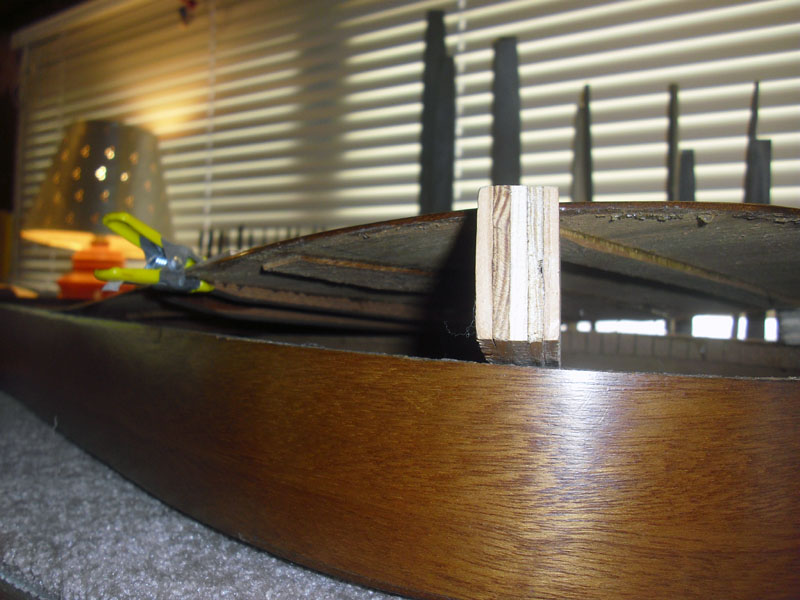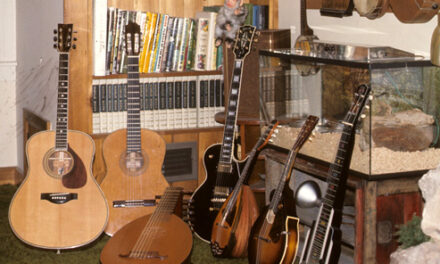
“Baby” being the unusual little Knutsen Hawaiian guitar on the far left, just back from restoration – bringing the total of my Knutsen “family” of steel guitars to 6.
For those not well versed in the Knutsen universe, I’ll give a quick overview of these instruments, which represent most (but not all) of Knutsen’s Hawaiian or steel guitars. For this discussion, I’ll just refer to them as #1,2,3, etc, counting from left to right. I’ll also include links to their full Knutsen Archives listing pages (#1 & 3 haven’t been added yet).
First off – why steel guitars on a harp guitar site?! Because Knutsen’s steel (or Hawaiian) guitars have always gone hand in hand with his harp guitars, mandolins and ukuleles. In fact, he advertised them all as his “New Hawaiian Family” beginning about 1914 (the new baby Hawaiian bearing this label).
All of his instruments came in “harp” versions, though the steel guitars first started out as “normal” 6-string instruments with the now-famous “Weissenborn” shape (a fellow Los Angeles luthier, Herman Weissenborn, would copy and improve upon Knutsen’s acoustic steel guitars, making this distinctive body shape synonymous with “Weissenborn”). Numbers 2, 3 & 4 in my line-up are of this Weissenborn shape, though as you can see, Knutsen would take the dimensions and adornments to creative extremes (#2 is the widest of these at almost 16-1/4″ while #3 is by far the skinniest, at 12-1/8″ wide, with a waist less than 6″!).
![]()
Being Knutsen, he would also add harp strings in all sorts of configurations. The most basic for the Weissenborn-shaped Hawaiians was a simple wooden bracket screwed on to the side to hold 2 sub-bass strings (#3).
![]() His next variation was to add 4 short treble strings on the opposite side (#4, link here). By the way, we still have no idea how Knutsen intended to tune any of these extra strings. To describe and inventory all these unique Knutsen instruments – which never had model or serial #s – I had to create a code system: “HHW” for instance refers to #3 & 4, which are Harp versions of Hawaiian guitars in the Weissenborn shape. Simple? Not really. From the beginning, we (both Noe & Most in their book, and myself) chose to refer to these instruments with the ungainly term “harp Hawaiian guitar.” Only recently did we realize a much better term is “harp steel” – coined, we think, by Knutsen himself (see this feature for that little research adventure). And, no, I’m not going to re-do my entire coding system!
His next variation was to add 4 short treble strings on the opposite side (#4, link here). By the way, we still have no idea how Knutsen intended to tune any of these extra strings. To describe and inventory all these unique Knutsen instruments – which never had model or serial #s – I had to create a code system: “HHW” for instance refers to #3 & 4, which are Harp versions of Hawaiian guitars in the Weissenborn shape. Simple? Not really. From the beginning, we (both Noe & Most in their book, and myself) chose to refer to these instruments with the ungainly term “harp Hawaiian guitar.” Only recently did we realize a much better term is “harp steel” – coined, we think, by Knutsen himself (see this feature for that little research adventure). And, no, I’m not going to re-do my entire coding system!

#2, which appears to be an overly-fancy 6-string, actually first left Knutsen’s shop as a left-handed version of #4, then came back for a full reversal to right-handed (all bass, neck and treble strings), then ended up as a 6-string – all within a short time in Knutsen’s own work.
This detective story is presented here.
 Now, things begin to get complicated. #5 is a now-“common” model that dealers always listed as a “harp guitar”…which, technically, it is, but it’s really a “convertible harp steel.” The crude neck, which can be played and fretted normally, is really designed to be played Hawaiian style on the lap, by raising the strings off the neck by pushing it forward on a sort of “hinged” neck heel, clamping down with a wingnut near the tuners, and then played with a slide bar. In this case, the skinny arm serves mainly as a secure spot for the wingnut and bracket, and also holds from 2 to 4 subs. About half the specimens also have a bank of 4 or more trebles strings).
Now, things begin to get complicated. #5 is a now-“common” model that dealers always listed as a “harp guitar”…which, technically, it is, but it’s really a “convertible harp steel.” The crude neck, which can be played and fretted normally, is really designed to be played Hawaiian style on the lap, by raising the strings off the neck by pushing it forward on a sort of “hinged” neck heel, clamping down with a wingnut near the tuners, and then played with a slide bar. In this case, the skinny arm serves mainly as a secure spot for the wingnut and bracket, and also holds from 2 to 4 subs. About half the specimens also have a bank of 4 or more trebles strings).
![]() OK, so the last one (#6) is surely an unadulterated harp guitar? Nope, though the full hollow arm with Knutsen’s normal 5 subs might make you think so. Check out the crude, hinged neck, the high slanted nut (Knutsen almost certainly supplied two nuts, for slide or normal playing – they’re held in place with a nail), and the 4 trebles common to the harp steels.
OK, so the last one (#6) is surely an unadulterated harp guitar? Nope, though the full hollow arm with Knutsen’s normal 5 subs might make you think so. Check out the crude, hinged neck, the high slanted nut (Knutsen almost certainly supplied two nuts, for slide or normal playing – they’re held in place with a nail), and the 4 trebles common to the harp steels.
This is a wild instrument in every way, including the “reverse-Fender” headstock and strange bass head.

Well, I certainly got side-tracked… I was going for a quick re-cap – all to introduce the original new steel, which is a whole new model…kind of. Knutsen’s two rarest forms of steel guitar are what we call the “Teardrop” and the “Pineapple” (see the first row at this link). This little guy is not quite either, as the sides are almost perfectly straight. There is just the slightest bump on the right side that looks like he may have been going for a pineapple but didn’t. The whole front and back sections are pretty crudely cut by hand – they’re very asymmetrical (more so than usual sloppy Knutsen) and don’t line up perfectly with each other. Still, I’ll probably lump this in with the pineapples (code HP), as I don’t think I need to add a whole new category just for this (HIT for Hawaiian shaped like an Isosceles Triangle?). It’s more of a “baby pineapple” – almost 3/4 scale, actually. Scale is 20-11/16″ whereas the others range from 23-1/4″ (2 & 3) to 24-3/4″.

All koa? No – my new repairman thinks this is quarter-sawn mahogany that was stained. The very lightly braced top and bridge were in perfect condition – ironically protected because the top-to-side kerfing glue joint was weak and had peeled cleanly off like a tin can (so did the back, a bit). Overall, an easy fix – it now appears all-original inside and out. I just have to figure out how to string and tune it safely…it’s got a nice, punchy sound!





